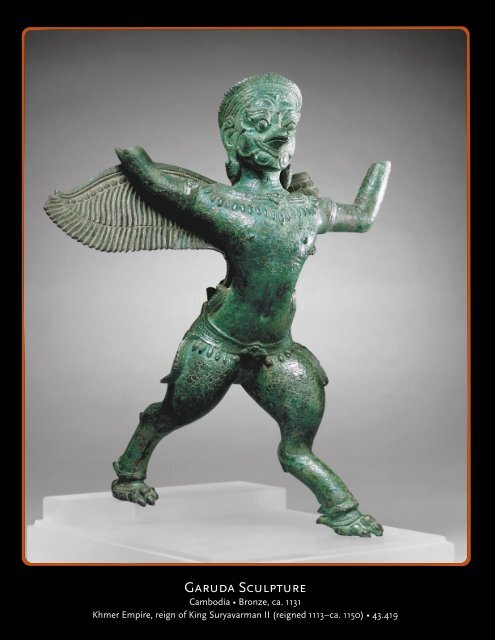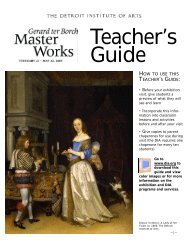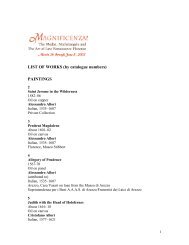Garuda Sculpture
Garuda Sculpture
Garuda Sculpture
Create successful ePaper yourself
Turn your PDF publications into a flip-book with our unique Google optimized e-Paper software.
<strong>Garuda</strong> <strong>Sculpture</strong><br />
Cambodia • Bronze, ca. 1131<br />
Khmer Empire, reign of King Suryavarman II (reigned 1113–ca. 1150) • 43.419
<strong>Garuda</strong> <strong>Sculpture</strong><br />
Cambodia<br />
Bronze, ca. 1131<br />
Khmer Empire, reign of King Suryavarman II<br />
(reigned 1113–ca. 1150)<br />
43.419<br />
<strong>Garuda</strong>, a bird-man creature, is a Hindu deity. In this sculpture the strong<br />
legs, talons, wings, and beak of an eagle are combined with the human<br />
torso and crowned head of a king. The figure wears a belt, necklace, two<br />
armbands, and elaborate earrings. Taking a forceful stride forward, <strong>Garuda</strong><br />
looks ready to fight, protect, or fly off. In the Hindu religion, gods travel the<br />
universe on creatures that symbolize their powers. <strong>Garuda</strong> carries the god<br />
Vishnu, roaming the world devouring evil. One of the three most important<br />
deities in Hinduism, Vishnu the Preserver keeps the world intact. If he<br />
withdrew for an instant, faithful Hindus believe the entire world would be<br />
destroyed. At the time this sculpture was made, the Khmer king of<br />
Cambodia, Suryavarman II (reigned 1113–ca. 1150), was considered a godking<br />
and the earthly manifestation of Vishnu. Suryavarman constructed an<br />
enormous temple complex, Angkor Wat, to validate his divine claim<br />
to govern.<br />
This <strong>Garuda</strong> figure is very similar to one found on a sandstone relief at<br />
Angkor Wat. Perhaps this <strong>Garuda</strong> was associated with the part of the<br />
temple where the relief was found or was connected with Suryavarman’s<br />
activities at the time. As a victor in the battle to preserve the universe,<br />
<strong>Garuda</strong> was considered a bird-king and was symbolic of Khmer royal power<br />
and strength. Refined, detailed, and elegant in style, this bronze <strong>Garuda</strong> was<br />
created using the lost-wax method of casting. It probably adorned an altar,<br />
and may once have had a sculpture of Vishnu mounted on its back.






